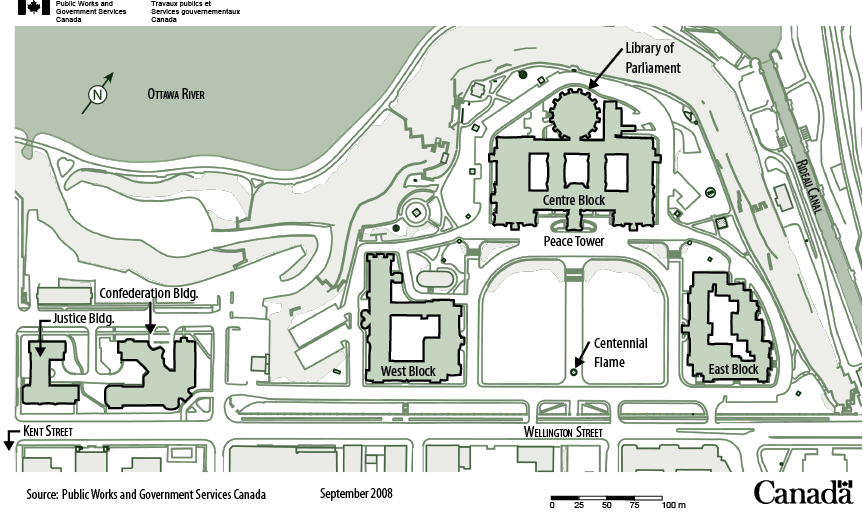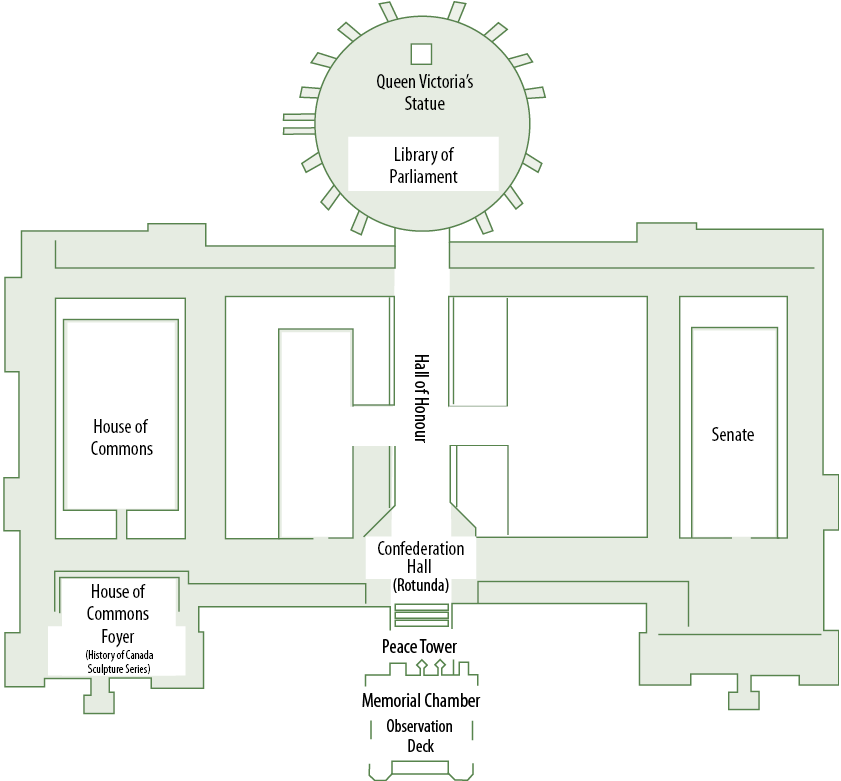Chapter 6The Physical and Administrative Setting
The Parliament Buildings and Grounds
Location and Disposition
The Parliament Buildings are situated on a cliff, originally a primeval forest of beech and hemlock, whose southern approach consisted of dense cedar swamps and a beaver meadow. The site,4 which was formerly the location of military barracks, overlooks the Ottawa River. It is bounded by Wellington Street to the south, the Rideau Canal to the east, the Ottawa River to the north and Kent Street to the west, and has the legal name of Parliament Hill5 (see Figure 6.1, « Parliament Hill »). The original complex of Gothic revival buildings constructed between 1859 and 1876, comprised the Parliament Building—fronted by a tower and backed by the Library of Parliament, a 16-sided polygonal structure—as well as two extant departmental buildings styled East Block and West Block.6 The Parliament Building, including the Victoria Tower,7 was destroyed by fire on February 3, 1916.8 Only the Library survived intact, saved in part by an employee who closed the iron doors connecting the Library to the rest of the building. For the next four years, both Houses of Parliament met several city blocks south of Parliament Hill in the Victoria Memorial Museum, now called the Canadian Museum of Nature.9

Sittings resumed in 1920 in the new but unfinished Centre Block, which was built on the same site as the old building.10 The new building was completed in 1922. A new tower, called the Peace Tower in commemoration of Canada’s human and material contributions to the First World War, was completed in 1927.
While originally sufficient to house the entire parliamentary and governmental apparatus, by the 1920s the Centre Block, East Block and West Block ceased to provide adequate accommodation as the size, complexity and functions of Parliament and government grew significantly. Today, government departments are housed in office buildings throughout the National Capital Region and elsewhere in the country. The Parliamentary Precinct—those premises which both Houses of Parliament “occupy from time to time for their corporate purposes”11—has expanded to include several other buildings in the immediate vicinity of Parliament Hill.12
The Centre Block is the permanent and intended location for the House of Commons and Senate Chambers. Committee rooms and offices for Members of Parliament are located in various buildings within the Parliamentary Precinct, and offices for House staff and parliamentary services are found within the precinct and in other locations throughout the National Capital Region. Since 1992, the precinct itself has been undergoing a series of renovations as part of the current Long Term Vision and Plan (LTVP), which is the master plan of improvements identified to address the deteriorating condition of buildings and grounds, as well as the requirements of Parliament.13
The grounds around Parliament Hill have undergone several stylistic transformations since Confederation but have always included a wide central walk leading from the gateway at the south end of the grounds to the main entrance at the base of the tower. At the southern end of the walkway is a fountain; in its centre burns the Centennial Flame, which was lit on New Year’s Eve 1966 to mark the first hundred years of Confederation (1867-1967).14 The fountain is a 12-sided truncated pyramid, each side holding a bronze shield bearing the coats of arms of a province or territory.15 Water flows continuously around the shields; the flame, fed by natural gas, burns through the water and gives the impression of the flame dancing over the water. Coins tossed into the fountain are retrieved to fund the Centennial Flame Research Award Fund.16
The grounds of Parliament Hill are the site of over 20 bronze statues, the first of which was erected in 1885.17 Represented are seven former Prime Ministers (John A. Macdonald, Alexander Mackenzie, Wilfrid Laurier, Robert Borden, William Lyon Mackenzie King, John Diefenbaker and Lester B. Pearson), five Fathers of Confederation (George-Étienne Cartier, a joint memorial to Robert Baldwin and Louis-Hippolyte Lafontaine, George Brown and Thomas D’Arcy McGee) and two monarchs (Victoria and Elizabeth II).18 There is also a monument dedicated to the “Famous Five” and their victory in the 1929 Persons Case,19 as well as another commemorating the War of 1812. Many of these statues have been temporarily relocated or removed as part of the ongoing LTVP renovations on Parliament Hill.
There are several other notable features found on the grounds of Parliament Hill. Behind Centre Block and facing the Ottawa River is the Summer Pavilion, a replica of a gazebo originally built in 1877 as part of the overall landscape plan for the grounds, but demolished in 1956. In 1995, the Summer Pavilion was rebuilt as a tribute to Canadian police and peace officers killed in the line of duty. Nearby, the Canadian Police and Peace Officers Memorial Honour Roll, which lists the names of each officer killed in the line of duty, is mounted along the fence separating Parliament Hill from the cliffs along the Ottawa River. Next to the Summer Pavilion is a monument displaying the Victoria Tower bell, one of the few artifacts which was recovered from the ruins of the 1916 fire which destroyed the original building.
Title, Management, Care and Control
Given Parliament’s right to administer its own affairs free from interference, including overseeing the areas used in the performance of official parliamentary functions, the Speakers of the two Houses have traditionally held authority and control over accommodation and services within the Parliamentary Precinct.20 At Confederation, Parliament Hill (including the adjacent parcel of land on which the Confederation Building stands) was transferred by the imperial government to Canada as “ordnance property”.21 As such, control of the grounds and construction, repair and maintenance of the buildings fell and continues to fall under the general mandate of a government department responsible for federal buildings and property. The National Capital Commission, a federal body whose mandate is the improvement and beautification of the National Capital Region,22 is charged with the landscaping and upkeep of the grounds of Parliament Hill.
The grounds of Parliament Hill are treated as a public park and are frequently used for recreational purposes by visitors. Organized public gatherings are also permitted on the grounds, although these require prior permission from the Committee on the Use of Parliament Hill. The Committee, which consists of representatives of the Senate, the House of Commons, the Parliamentary Protective Service (PPS), the Royal Canadian Mounted Police (RCMP), the National Capital Commission (NCC), the Privy Council Office, and the departments of Canadian Heritage and Public Works and Government Services, ensures that the proposed activity does not obstruct the work of Parliament or have a negative impact on the heritage character of the grounds.
Long Term Vision and Plan (LTVP) for the Parliamentary Precinct
As custodians of the Parliament Buildings, Public Works and Government Services has worked closely with its parliamentary partners—the Senate, the House of Commons and the Library of Parliament—to develop and implement the Long Term Vision and Plan. The LTVP is a master plan for improvements to the Parliamentary Precinct spanning a 25- to 30-year period. It provides a detailed assessment of current and future requirements in terms of planning, renovations and new construction work in the Parliamentary Precinct.
This plan is implemented in rolling five-year programs of work designed to address the deteriorating condition of buildings and grounds, the working requirements of Parliament and managing access to the visiting public. As the LTVP is carried out, the need to provide interim accommodation for core parliamentary and support functions is met by temporarily repurposing a number of buildings in or near the Parliamentary Precinct. As such, committee rooms are housed in different buildings at different points in time, with the most significant interim accommodations being that of a temporary Commons Chamber in the West Block courtyard and a temporary Senate Chamber in the Government Conference Centre.23
The following description of the physical setting of the Parliamentary Precinct focuses on the permanent and intended accommodation of core and support functions prior to and following the implementation of the LTVP.
Centre Block
Built from the plans of architects John A. Pearson and Jean-Omer Marchand in a modern Gothic revival style, the rectangular Centre Block is 144 metres long by 75 metres deep, and six storeys high.24 More than 25 different types of stone were used in the building’s construction; however, much of the exterior is Nepean sandstone, quarried near Ottawa, and its interior walls are sheeted with Tyndall limestone from Manitoba. Inside, the history and traditions of Canada are reflected in many stone carvings which are the result of the ongoing intermittent work of over 60 sculptors and carvers since 1916.25
The main entrance to the Centre Block is located at the base of the Peace Tower, where a broad flight of steps leads into a stately Gothic archway. The main doors open onto stairs leading up into the octagonal Confederation Hall (commonly called the Rotunda) and the Hall of Honour, which leads to the Library of Parliament (see Figure 6.2, “Floor Plan of the Centre Block”). In the centre of Confederation Hall is a massive stone column dedicating the building to the Canadian soldiers who fought in the First World War. The Hall is decorated with sculptures of the coats of arms of Canada, the provinces and their capital cities, the territories, as well as depictions of Canadian flora and fauna. The Senate Chamber is situated at the eastern end of the Centre Block, and the House of Commons Chamber at the western end. Each House has a separate entrance to the building for its members.
Peace Tower
The Peace Tower, with its four-faced clock, is the focal point of the Parliament Buildings. It commemorates Canada’s contributions to the First World War and, on its third floor, houses the Memorial Chamber, which holds the seven Books of Remembrance naming those Canadians who have given their lives in service to Canada. An enclosed observation deck below the clock offers a 360-degree view of the National Capital Region. The Tower, which is 92.2 metres high, is surmounted by a flagpole.26

The Peace Tower also contains a carillon of 53 bells, inaugurated on July 1, 1927, on the occasion of the Diamond Jubilee of Confederation.27 Regular recitals are given by the Dominion Carillonneur.28 The bells chime every quarter hour,29 controlled by a mechanism connected to the clock.
Library of Parliament
At the north end of the Centre Block’s Hall of Honour, opposite the main entrance, are the doors to the Library of Parliament building. Its style of architecture is High Victorian Gothic revival; its interior is circular in form and richly ornamented with carved native white pine panelling. The Library survived the fire of 1916, but in 1952 a fire broke out in the cupola of the Library causing extensive smoke and water damage. From 2002 to 2006, the historic Library of Parliament building was closed for conservation, rehabilitation, and upgrading of the building. Damage which the building had sustained over the years was repaired and current building standards were met while preserving the Library’s existing features and heritage character. During this period, the Library’s collections were stored in various other buildings occupied by the Parliament of Canada, and its services were not interrupted. The Library of Parliament reopened its doors on May 30, 2006. There are also branch libraries in some buildings in the Parliamentary Precinct.30
Under the direction of the Parliamentary Librarian,31 the Library provides comprehensive information, research and analysis services to parliamentarians, their staff, parliamentary committees, parliamentary associations and delegations, and senior officials of both Houses. It also provides information about Parliament to the general public.32